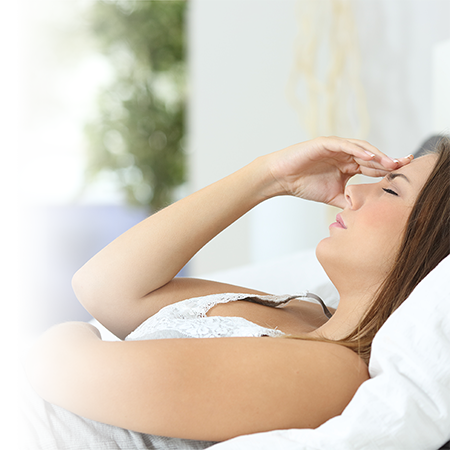Premenstrual syndrome (PMS) is a topic of discussion for many women... and men. So, let's talk about it, to clear the air on the subject.
Premenstrual syndrome: myth or reality?
Premenstrual syndrome, often referred to by its abbreviation "PMS", sometimes gets a bad rap. The popular expression "being in PMS" is often not complimentary. It usually refers to a woman who experiences irritability, mood swings or emotional fragility, for example. While some people experience the drawbacks on a cyclical basis, others doubt its very existence.
Yet, PMS is not a myth. It is important to note that it is not an illness per se, but rather a set of symptoms that appear at a certain time during the menstrual cycle in women predisposed to it. More specifically, it is during the luteal phase (between ovulation and the start of menstruation) that women experience its inconveniences. This is why we say that PMS predicts the imminent onset of menstruation.
The more severe form of PMS is referred to as "premenstrual dysphoric disorder".
How does PMS manifest itself?
Each woman is unique and may feel a variety of PMS-related symptoms, such as the following:
- fatigue
- low energy
- sadness and tears
- mood swings and angry outbursts
- anxiety or excessive worrying
- feeling of discouragement
- irritability or aggressiveness
- concentration problems
- swollen or sensitive breasts
- insomnia or hypersomnia (oversleeping)
- headaches
- increased hunger or food cravings
- bloating
Symptoms can vary from one cycle to another, and usually lasts between 5 and 14 days. Most often, they dissipate during menstruation. They are sometimes mild and do not really affect a woman's performance. In other cases, symptoms disrupt daily activities and interpersonal relationships.
How do you know if you have PMS?
At this time, it is not known why some women suffer from PMS and others do not. That said, there seems to be a fairly clear link to cyclical hormonal changes.
There is no medical test to diagnose PMS. The doctor's evaluation will first be based on the description of the symptoms. It is important to obtain a diagnosis, since symptoms can be attributed to other conditions or health problems (depression, anxiety disorder, burn-out, perimenopause, etc.) with which PMS is sometimes confused.
To facilitate the assessment, the doctor sometimes asks the person to keep a journal describing symptoms over several menstrual cycles.
What can be done to reduce PMS symptoms?
Because PMS is not an illness, it cannot be "cured". However, it can be eased by various means, including lifestyle changes.
- Engage in regular aerobic activity such as walking, jogging, swimming or cycling.
- Choose a healthy and balanced diet. Limit your intake of food and drinks that are rich in sugar, salt, caffeine, and alcohol.
- Get plenty of sleep.
- Learn how to better manage stress.
- Familiarize yourself with a relaxation technique (yoga, meditation, visualization, deep breathing, etc.).
- Meet with a specialist who can help you better manage some of the symptoms you are experiencing, such as a psychologist.
For some women, the use of medication will be considered to better manage symptoms and improve well-being and quality of life. The choice of medication will depend on the nature and intensity of symptoms, among other factors. Since several symptoms can occur, various treatments will be considered:
- hormonal (e.g., oral contraceptive)
- antidepressant
- antianxiety medication
- sedative
- analgesic
- etc.
For women who wish to take vitamin and mineral supplements or natural health products, it is important to always consult a pharmacist before taking this type of product. They can provide you with information about its effectiveness and benefits (if any), warnings and precautions, drug interactions, side effects and dosage.
Speak to your doctor and pharmacist if you think you have PMS. They can help you find solutions to lessen the impact on your life. Every woman wants to achieve lasting wellness and deserves all the help needed to achieve it!

